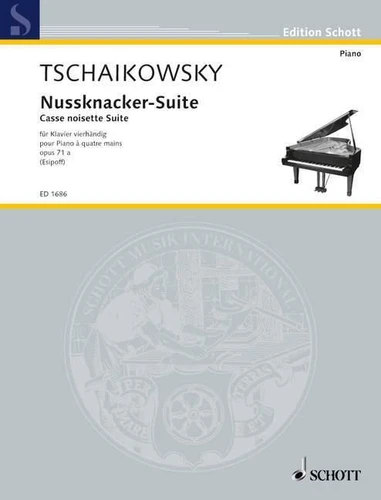Edition Schott
Casse - Noisette - Suite. op. 71a. piano (4 hands).
Par : Formats :
- Paiement en ligne :
- Livraison à domicile ou en point Mondial Relay indisponible
- Retrait Click and Collect en magasin gratuit
- Réservation en ligne avec paiement en magasin :
- Indisponible pour réserver et payer en magasin
- Nombre de pages64
- Poids0.264 kg
- Dimensions23,1 cm × 30,3 cm × 0,0 cm
- ISBNM-001-17988-8
- EAN9790001179881
- Date de parution01/01/2000
- CollectionPIANO
- ÉditeurSchott
- EditeurStépan Esipoff
Résumé
The Nutcracker Suite is a piano arrangement of the concert version of the ballet of that name. Tchaikovsky used only part of the music for the ballet in the suite. The Overture, and the March which is the most important of the characteristic dances in the Suite, come from the first act of the ballet. The remaining dances originate from the second act. They are : The Dance of the Sugar Plum Fairy, in which the leading part is, in the original composition, played typically by the celeste almost all the way through ; the fiery Russian "Trepak" which reminds us of Tchaikovsky's national origins ; the Arab Dance tinged with a gentle melancholy ; the Chinese Dance with its tripping ostinato rhythm ; the graceful Dance of the Reed Flutes ; and finally the longest piece in the Suite : the Waltz of the Flowers in which Tchaikovsky, writing in the penultimate year of his life, showed his musical affinity with Johann Strauss.
The Nutcracker Suite was perfomed for the first time, with great success, on 7 March 1892 at the Ninth Symphony Concert of the Russian Musical Society in St Petersburg. Instrumentation : piano (4 hands) op. 71a
The Nutcracker Suite was perfomed for the first time, with great success, on 7 March 1892 at the Ninth Symphony Concert of the Russian Musical Society in St Petersburg. Instrumentation : piano (4 hands) op. 71a
The Nutcracker Suite is a piano arrangement of the concert version of the ballet of that name. Tchaikovsky used only part of the music for the ballet in the suite. The Overture, and the March which is the most important of the characteristic dances in the Suite, come from the first act of the ballet. The remaining dances originate from the second act. They are : The Dance of the Sugar Plum Fairy, in which the leading part is, in the original composition, played typically by the celeste almost all the way through ; the fiery Russian "Trepak" which reminds us of Tchaikovsky's national origins ; the Arab Dance tinged with a gentle melancholy ; the Chinese Dance with its tripping ostinato rhythm ; the graceful Dance of the Reed Flutes ; and finally the longest piece in the Suite : the Waltz of the Flowers in which Tchaikovsky, writing in the penultimate year of his life, showed his musical affinity with Johann Strauss.
The Nutcracker Suite was perfomed for the first time, with great success, on 7 March 1892 at the Ninth Symphony Concert of the Russian Musical Society in St Petersburg. Instrumentation : piano (4 hands) op. 71a
The Nutcracker Suite was perfomed for the first time, with great success, on 7 March 1892 at the Ninth Symphony Concert of the Russian Musical Society in St Petersburg. Instrumentation : piano (4 hands) op. 71a


